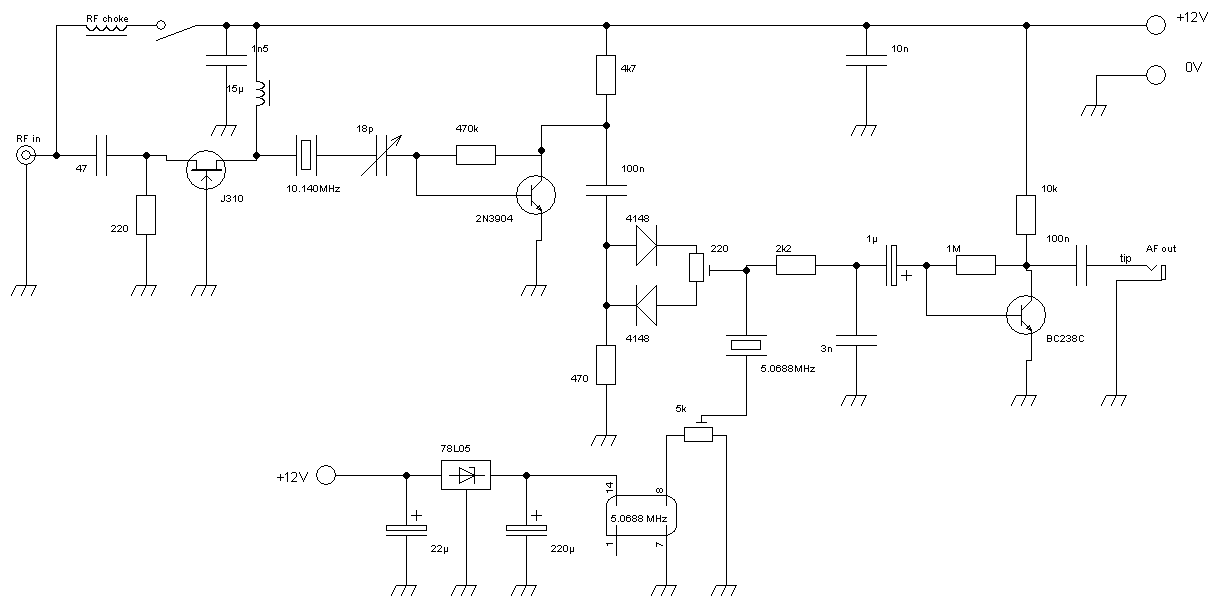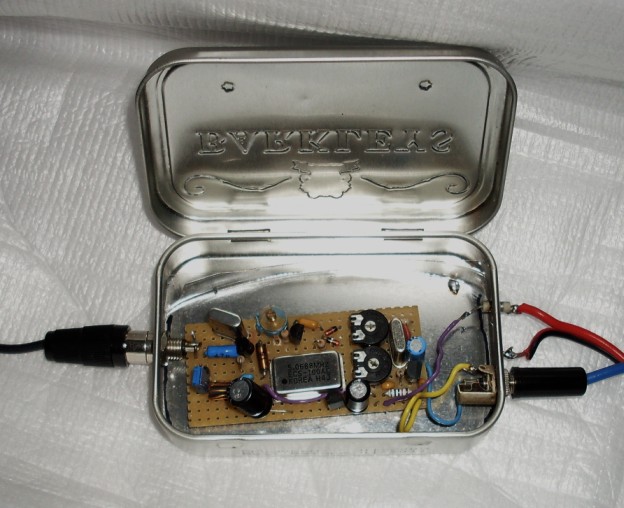30m QRSS Grabber Receiver
The basic design is a mix of ideas gathered from pa2ohh, the ARRL Handbook and publications made about the subharmonic mixer of Prof. Polyakov (ra3aae).
Since I am a really lazy dawg, thinking came first...
What we want to observe is 10140000 to 10140100Hz. Let's see what is available.... 10.140MHz crystals, close, but too close for comfort. Pull those crystals, and oscillators will become less stable. 10.125MHz crystals... too far off! 10.135MHz, closer, possible, but still pretty far off; 5kHz, oh my goodness!
But we also got really cheap and well available crystals and oscillators (!) at 5.0688MHz. Multiply by two and we are at 10.1376MHz, that's just 2.4kHz off the lowest frequency we want to receive. 2400-2500Hz also is in the comfort zone of any random soundcard at even low sampling rate.
To use this particular frequency, all we need to do is, multiply by two, or in other words, double it.
Jan (pa9qv/oz9qv) pointed me towards Prof. Polyakov's mixer, also known as the Russian mixer. Great readings from late la8ak, check this out: http://noding.com/la8ak/c21.htm
Thus, there we are, ultra-cheap 5.0688MHz CMOS-oscillators combined with a Russian mixer receives the 30m-qrss-band at about 2.4kHz. Let's design something!
Final design
A Polyakov mixer is supposed to work best with a sine signal. The
CMOS-oscillator's signal however looks more like a squarewave,
involving a lot of harmonics. The easiest and cheapest way, as it
seemed to me, to transform that into a sine, is a crystal in series
resonance.The unwanted lower sideband has been taken care of by including a 10.140MHz-crystal behind the preamp.
Behind the filter, a RF-amp is added to compensate for losses. Due to this, the filter response is now shifted up again, I will look into this, but for now, I will let the receiver run and collect data/info.
As promised, I looked into it, shifting a crystal up is done by capacitive load. Reducing this load will bring the crystal closer to its series resonance frequency. To be a little bit on the adjustable side this time, I added a trimmer found in my junk box. I thought it would have a max. capacity of 18pF. This trimmer allows for adjustment of the crystal filter pass band frequency.
Consideration for operations w/o the filter: we are looking at a bandwidth of 100Hz and the received LSB will be (about) 10135100Hz to 10135200Hz. I figure, there is just the occasional Feldhell QSO, but other than that, the LSB range of the DSB receiver seems to be an empty spot.
A jumper is added in order to enable support of an active antenna via coax cable. The ideas for an active aerial are floating presently. It will be a shielded resonant loop with a preamp, that's for sure. The loop will be made from "YMVK-as 2x2.5mm²" which is underground twin-lead mains cable, doubly shielded. In an earlier experiment I successfully made a 40m-75m RX-loop from that stuff.
 | |
| Subharmonic 30m direct-conversion receiver |
Photo of the 30m direct conversion receiver
 | |
| The actual receiver, as running for many years |